Hello, Fellow Readers. The printed version of our column in The Press is back on the stands. It’s nice to see some things returning to how they used to be. Others will never be the same, which is always the case. A sure thing in life is it’s ever-changing. May a rainbow of Hope, Peace, and Love follow this storm, which brings me to a story of a Forest Pansy Redbud Tree planted in memory of an extraordinary young man.
Forest Pansy Redbuds make a remarkable memorial tree.
In the fall, we planted a tree at Morristown High School (NJ) in memory of Myles, a remarkable young man. Myles of smiles is a contagious phrase that describes how he brightened the world with his presence and kindness to all who had the privilege of sharing a bit of his life—no matter our walk in life.
Myles loved bright colors, especially reds, so we chose a Forest Pansy Redbud for its glorious colors throughout the year. From the hot pink blooms that coat the branches in spring to the unfurling leaves that grow into shiny reddish-purple hearts that deepen to maroon as they mature, the canopy turns into a flame of reds, yellows, and oranges come fall.
A spring frost damaged the leaves.
Margarita, a knowledgeable plantswoman, organized the planting and continues to take loving care of Myles’ tree. Earlier, it was doing beautifully, she said. The flower buds formed and were ready to burst into bloom, and the leaves were beginning to emerge. Then, upon her next visit, there was a devastating decline. She sent photos of the withered leaves, which I forwarded to the nursery, which confirmed that it was frost damage from the two nights below freezing.
Redbuds decline if they are too wet.
Cercis canadensis’ Forest Pansy’ is native to eastern and central North America. This deer-resistant beauty is hardy in zones 6 through 8, growing about twenty-five feet tall and wide. Redbuds prefer full sun in milder zones like ours and part shade in hotter climates. While they can tolerate clay soil, the soil must drain well as it declines quickly if too wet.
Once established, Redbuds will tolerate occasional drought, but consistently moist soil is crucial during its first few years after planting. And so Margarita installed a nifty tree gator- a slow-release watering bag that drips water over five to nine hours with each fill. One fill typically provides enough moisture to last a newly planted one to two-inch caliper tree for up to seven days. There are larger bags for more significant trees. FYI- the caliper is the width of the trunk.
Tree gators can simplify watering a newly planted tree.
Using a tree gator requires management. If there’s plenty of rainfall, don’t fill the tree gator. Soil that’s too wet for too long depletes oxygen to the roots, eventually killing a tree. If it’s excessively hot and dry, the bag may need to be filled more than once a week. For now, Ben Jansen of Jansen Nursery advised that we only let nature water the tree.
“Too much water will add stress to an already stressed tree that needs to put energy into pushing out a new set of leaves,” Ben said, adding, “Redbuds are particularly finicky about too much water.”
Margarita reports pliable twigs and branches that promise life. Once the leaves emerge, we will test the soil with a moisture meter and reinstall the tree gator if Mother Nature does not provide enough rainfall.
I’ve witnessed two fall-planted Japanese maples whose leaves froze, shriveled and dropped after the two-night freeze. They’ve rebounded beautifully. There is indeed Hope. Garden Dilemmas? Ask Mary Stone@gmail.com (and now on your favorite Podcast App).
This story is featured in Episode 21 of the Garden Dilemmas Podcast:
You’ll enjoy a previous column about healing and growth titled A Butterfly Garden of Growth
as well as the “coincidence” of the heart-shaped leaves of Redbud featured at a recent Hospice Butterfly Release


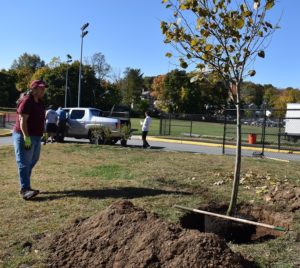
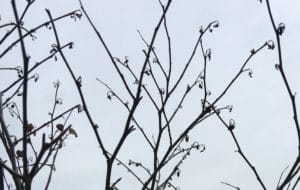
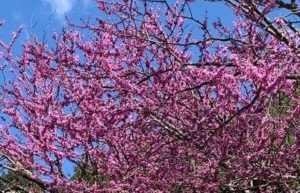
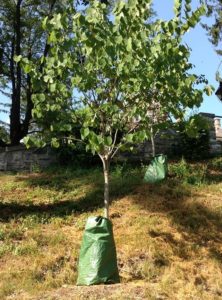
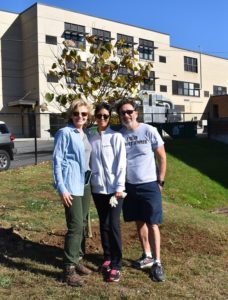



So interesting! My, has my H.S. changed! Miss the old look, but love that tree.
Hi Diane, It sure is an impressive place. Far fancier than our West Chester PA High School was long ago. Since then, it’s been enlarged and renovated and looks like a college campus. Comforting the Forest Pansy Redbud remains the same magnificent tree. Thanks for reading my column :^), Mary